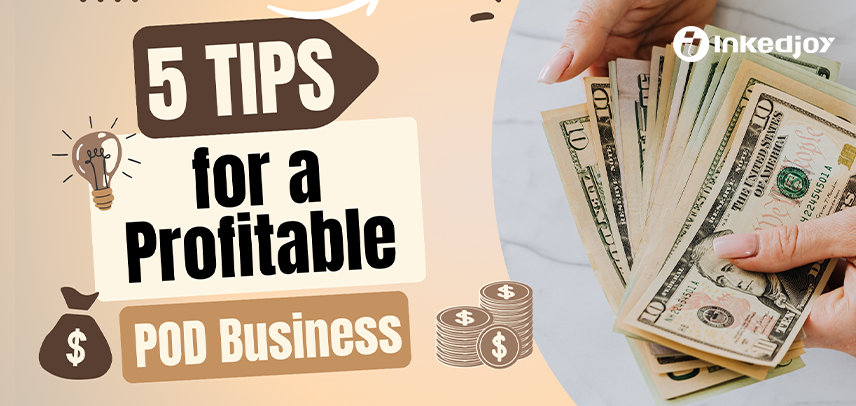
5 Tips for a Profitable POD Business (POD Pro Tips)
The Print on Demand (POD) business model lets you work with a supplier to sell custom-designed items. You create designs for items like t-shirts and mugs, list them online, and when a customer places an order, your supplier prints and ships the item. The great thing about POD is that you don’t have to pay for inventory upfront, which lowers your risk. The POD market is growing quickly and is expected to reach $563.9 million by 2030. Sellers can often make profit margins of 15–30%, and sometimes even up to 50%.
However, it’s competitive, and individual items have lower profits than bulk orders. To be successful in POD, you need to work hard and consistently. This text gives you five professional tips for a profitable POD business.
Page overview:
Tip 1: Strategic Niche and Audience Selection for POD Success
Pinpoint Your Profitable POD Niche
Understand Your Ideal POD Target Audience
Research and Validate Your Chosen POD Niche
Tip 2: Create Unique Designs and Offer Quality POD Products
Tip 3: Master Your Pricing Strategy for Profitability
Tip 4: Implement Targeted Marketing & Build Your Brand Identity
Tip 5: Prioritize Excellent POD Customer Experience and Service
Tip 1: Strategic Niche and Audience Selection for POD Success
A great start in POD means knowing what to sell and to whom. Being specific makes your efforts more effective and helps you stand out from the crowd.
Pinpoint Your Profitable POD Niche
Don’t try to sell everything. Choose a niche category to attract dedicated customers and possess fewer competitors. Think “sci-fi yoga wear” instead of just “apparel,” or “mugs for avid gardeners”. A niche allows for customized products and marketing, making your business more identifiable and interesting to a specific group.
Understand Your Ideal POD Target Audience
After setting your niche, get to know your potential customers. Who are they? What’s important to them? What problems can your products solve for them, and what will they pay? Making customer profiles will assist. Know their age, interests, and web behaviors to inform your designs and marketing.
Research and Validate Your Chosen POD Niche
Validate your niche with research.
- Learn what people are searching for by following market trends and using keyword tools. For instance, detailed market reports indicate significant growth trends within specific regions, like North America, which can inform strategic business decisions.
- Use social media to find groups that are active and linked to your niche.
- Look at your competitors to get a sense of what’s already out there and find holes you can fill. This makes sure there is demand and keeps markets from getting overly saturated.
Tip 2: Create Unique Designs and Offer Quality POD Products

- Original and Eye-catching POD Designs. Your designs differentiate your products. Invest in making unique, clean images that resonate with your target audience. Monitor trends but aim for uniqueness. Avoid generic art. Originality creates your brand and sets your products apart. Ensure designs are high-resolution and print-ready.
- High-Quality Print on Demand Products. Product and printing quality is important. Always order samples before selling. Check the material of the product, print accuracy, color vibrancy, and durability. Quality products mean happier customers, better reviews, and less return. Therefore, you need to work with reputable POD suppliers with a good reputation for quality.
- Wise POD Product Catalog Choice. Select products that fit your niche and appeal to your buyer. Sell fashionable items like t-shirts, but don’t limit yourself to those; also select unique products that fit your brand. Organic cotton or reusable bags are wonderful for an eco-conscious niche. A well-chosen catalog can boost sales.
Tip 3: Master Your Pricing Strategy for Profitability
A Print-on-Demand business that makes money needs to have a clear picture of all the costs involved. A lot of companies overlook hidden expenses that can quickly eat away their small profit margins. A thorough cost analysis should include:
| Cost Category | Description |
|---|---|
| Production Costs | Base cost from the POD provider for manufacturing and printing. |
| Design Costs | Expense of design, whether outsourced or self-created. |
| Shipping Costs | A significant component, often 10% to 30% of total product cost, higher than bulk shipping. |
| Platform Fees | E-commerce platform and payment gateway fees, typically 3% to 10% of the sale price. |
| Marketing Expenses | Budget for advertising and promotions, which can be 15% to 25% of revenue. |
| Taxes | Applicable sales taxes or VAT. |
| Overhead/Buffer | A small buffer for unexpected issues like returns or defects. |
- Pricing for value (not just cost)
- Researching competitor prices
- Upselling and cross-selling
- Bundling products
- Offering limited-time promotions
- Customer personalization
- Creating scarcity with limited-edition designs
Tip 4: Implement Targeted Marketing & Build Your Brand Identity
As was already said, you need to know who your ideal customer is, or your buyer persona, before you start any marketing campaign. By making designs, language, and images that are specific to this persona, marketing is more likely to resonate with them deeply and other likely buyers. In competitive POD markets, this targeted approach protects against high marketing costs and low customer loyalty. It leads to lower ad spend, higher conversion rates, and stronger brand loyalty.
Understanding how leading print-on-demand entrepreneurs have achieved significant market dominance, often by establishing a strong independent online store, can offer powerful lessons.
| Marketing Channel | How to Do |
|---|---|
| Showcase products visually via posts, stories, reels; use hashtags for reach. | |
| TikTok | Reach younger audiences (18-34) with engaging, entertaining content (e.g., behind-the-scenes, styling tips). Direct store integrations available in U.S./U.K. |
| Visual search engine; link pins directly to store using high-quality product photos. | |
| Online Groups & Communities | Engage authentically in niche forums (Facebook Groups, Reddit, Discord) by providing value, not just promotions. |
| Email Marketing | Highly effective for promotions and updates; build list with incentives (e.g., discount codes). |
| Paid Advertising (PPC) | Increase visibility and drive targeted traffic via Google Ads, Facebook Ads, TikTok promotions. Start small, track, refine. |
| Search Engine Optimization (SEO) | Ensure prominent search engine appearance by using niche-specific keywords in product descriptions, blog content, and website copy. |
- Influencer Marketing: Work with micro- or nano-influencers in your field. Their active followers can promote goods through reviews or sponsored posts, which boosts credibility.
- Social Proof: Use customer reviews, user-generated pictures, or “X+ sold this month” badges to get more people to buy. To build trust, actively request and showcase testimonials.
- Contests and Giveaways: Giving away custom clothing as gifts can generate buzz and improve brand awareness. Keep entry rules as simple as possible.
- Wear Your Own Merch: This is a real and inexpensive way to market your business. You can get sample discounts from POD platforms to try and promote your content. Wearing your merchandise can spark curiosity and conversations.
Tip 5: Prioritize Excellent POD Customer Experience and Service
A great customer experience is important for building brand strength and long-term success. This is especially true for Print-On-Demand (POD) businesses that have to deal with inherent limitations like dependence on third-party suppliers.
- Key to this is to make the ordering process easier and give clear, thorough information about the products. A website that is easy to use, has clear navigation, can be customized easily, and has comprehensive details (like materials, size charts, colors, and prices) empowers informed decisions and reduces the number of returns because of confusion.
- Timely answers to questions and quick settlement of problems are also very important. Prompt responses is necessary for both pre-sale questions or after-sale issues. Setting clear, fair rules for refunds, returns, or changes, and putting customer satisfaction first when problems appear, can turn frustrating situations into chances to build deeper trust and loyalty.
- Also, being able to reliably track orders and have personalized conversations makes the experience much better. Customers are less anxious when they know the state of their orders in real time, and thoughtful, personal touches like thank-you notes can leave a good impression that goes beyond the transaction itself.
- Finally, actively soliciting and using customer feedback through surveys or reviews shows a dedication to constant improvement. This lets customers know that their thoughts are valued and are used to improve products and services, ultimately strengthening the brand.
In a nutshell, outstanding customer service acts as a powerful buffer against the operational challenges of the POD model, building strong relationships with customers and a good reputation in the market that are necessary for long-term growth.
Make Your Path to a Profitable POD Business
The POD model offers a low-risk, scalable e-commerce entry point. A profitable Print on Demand business is achievable with dedication and smart planning. It’s not instant wealth. Success depends on strategic niche selection, unique designs, intelligent pricing, effective marketing, and excellent customer service. While the landscape is competitive, understanding the current profitability and practical steps for success is crucial for anyone considering this business model. With rising demand for personalized products, applying these tips can help you tap into POD’s significant income potential.



